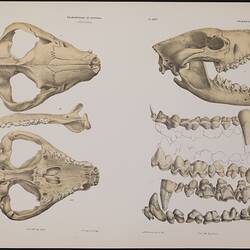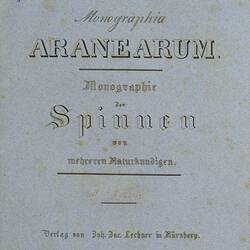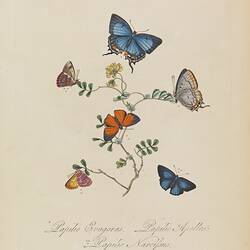The current-day Museums Victoria Library collection is founded on the libraries of two nineteenth century predecessors, the National Museum of Victoria (NMV) and the Industrial & Technological Museum (later the Science Museum of Victoria.) These collections merged in 1983 when the Museum of Victoria formed. Of these library collections, the NMV collection was the larger and more historic (Job 2001). This article covers the early development of the NMV Library, from 1855 when records begin, until the death of the museum's first director, Frederick McCoy, in 1899.
Professor McCoy exerted a great deal of influence over the library's development in its early years. There were already some books in the collection when McCoy joined the museum in 1856, however, he was the first to undertake strategic collection development of the library for an extended period. Nine hundred pounds was spent up to 1858 when McCoy became director, some of this by the museum's first curator William Blandowski (Stephens 2013, p. 271). Some of these acquisitions appear to predate the establishment of the records in 1855, and likely occurred when the museum was founded in 1854. In the 1850s and 1860s McCoy spent a substantial sum establishing a scientific reference library "for classification", as he explained to the government when requesting funds in 1859 (Pescott 1954, p. 44). This was part of an enormous outlay of £80,000 spent establishing collections, buildings and equipment for the museum in McCoy's first decade as director (Rasmussen 2001, p. 64).
McCoy has been described as "the greatest museum builder in Australia" (Moyal 1986, p. 94-95), in reference to his diligence in acquiring collections; he required a library to assist classification of the extensive collections he amassed. Significantly, one of McCoy's primary claims to leadership at the museum appears to have been his preference for academic research rather than fieldwork. He argued that the "naming or literary investigations" of specimens needed "patient study in the closet and a large library" (Rasmussen 2001, p. 39).
Between 1855 and 1869 the National Museum of Victoria spent nearly £3500 on books and periodicals, which was a significant investment for a museum or society library (Stephens 2013, p. 273). While establishing the library, McCoy purchased most books from London, through the offices of the Victorian Agent General. Account books show that he purchased through several English booksellers, some local suppliers and one German bookseller. Starting in 1855, purchases from Macmillan & Co., included standard reference works in a variety of scientific disciplines, zoologies of particular regions, and accounts of exploration, especially those focussing on Australia (Museums Victoria, 1855-1878, pp. 1-23). Notable purchases include Zoology of New Holland and Zoology of the Voyage of the Beagle. Authors included James Sowerby, William Swainson, John James Audubon, and Joseph Dalton Hooker. Macmillan also handled the purchase of Conchologia Iconica from author Lovell Reeve - presumably to accompany the shell collection of Reeve's that McCoy also purchased. Although most of the initial Macmillan purchases were monographs, McCoy slowly built up the collection of periodicals, beginning with the publications of the Linnaean Society and Zoological Society of London. He gradually added to these subscriptions until 1864, after which he mainly seems to have relied on the company to maintain them.
Another major supplier of books to the National Museum was Williams & Norgate. These orders took place over 10 years, between 1855 and 1865, and included more French and German titles than the Macmillan orders, which were predominantly English language publications (Museums Victoria 1855-1878, pp. 51-85). Notable acquisitions include Albertus Seba's Locupletissimi rerum naturalium thesauri accurata description, known in English as his Thesaurus. Two copies of this work were acquired after McCoy mistakenly received a black and white version instead of a coloured copy. Other acquisitions included John Lewin's Natural history of lepidopterous insects of New South Wales, Edward Donovan's An epitome of the natural history of the insects of New Holland, and Hahn's Monographia Aranearum or Monographie de Spinnen. Prominent authors acquired from Williams & Norgate include Georges Cuvier, Jean-Baptiste Lamarck, Coenraad Jacob Temminck, J. O. Westwood, Louis Agassiz, Carl Ludwig Koch and Francois Levaillant.
To a lesser degree, McCoy also utilised the English bookseller Bernard Quarritch. These acquisitions took place from 1860 to 1866, and the most notable purchase was the first folio edition of Maria Sybilla Merian's Insects of Europe and Insects of Suriname, bound together in a beautiful late 18th century tree-calf binding (Museums Victoria 1855-1878, pp. 39-42).
Although McCoy initially relied on English booksellers, he did utilise local suppliers during this period, including George Robertson and Ferdinand François Bailliere. The Robertson purchases reveal a practical focus, including books on topics such as animal husbandry, agriculture, manuals and other technical books (Museums Victoria 1855-1878, p. 101). Purchases from Bailliere were more academic and included some French and German titles in addition to English language texts (Museums Victoria 1855-1878, pp. 25-29). Notable authors included Louis Agassiz, Georges Cuvier, Georges-Louis Leclerc Comte de Buffon, Richard Owens and Rene Primavere Lesson. A significant acquisition was John White's Journey of a voyage to New South Wales.
Less commonly, McCoy purchased books directly from authors, as was the case with English ornithologist John Gould. Aside from his publishing activities, Gould traded in specimens, and in 1857 McCoy reached out to take advantage of these services. McCoy corresponded with Gould from 1857 until 1870, acquiring over 5,000 specimens during this time (Fleming 2001, p. 210). The letters and invoice books in the Museums Victoria Archives show that he also purchased a number of Gould's publications, encouraged by Gould to make these purchases directly. During this period McCoy acquired the supplement to Birds of Australia, Mammals of Australia, Birds of Great Britain, and Birds of New Guinea. He also acquired Gould's series on Hummingbirds, Toucans and Trogons. Many of these were supplied in parts, while in some cases Gould arranged for them to be bound into volumes before they were shipped to Melbourne.
In 1864 government funding to the museum was reduced. McCoy's autonomy declined further following the 1870 Library, Museums, and National Gallery Act, which brought the museum under control of a joint Board of Trustees (Job 2001). After 1864 acquisitions of books and periodicals tapered off, and the Accounts Ledger from 1872 to 1885 shows a particularly lean period. However, McCoy continued to make small purchases on a yearly basis, mainly from local bookseller Samuel Mullen.
Despite the depression of the 1890s, the account books show a slight improvement compared to the previous two decades. In 1890 McCoy placed a substantial order with German bookseller Felix L. Dames, who specialised in scientific and natural history literature (Museums Victoria 1889-1909, pp. 28-29). This was the first purchase from an overseas supplier in some years. Other acquisitions for this period are journal issues from Macmillen, including volumes of the scientifically and artistically significant Report on the scientific results of the voyage of H.M.S. Challenger during the years 1873-76. Monographs continued to be purchased in small numbers from Samuel Mullen.
Aside from purchases, another major means of collection development for the library was its exchange program with scientific institutions around the world. This began with McCoy's publication Prodromus of the Palaeontology of Victoria (1870) and the Prodromus of the Zoology of Victoria (1878) and was later continued by the Memoirs of the National Museum of Victoria from 1906. The exchange program started with Australian and American titles and grew to include titles from Germany, Sweden, India, Canada, South Africa, Buenos Aries, Monaco and Uruguay. The program expanded rapidly in the last decade of the 19th century, and by 1899 when McCoy died, the museum was exchanging numerous publications with 36 institutions worldwide. Towards the end of the 19th century exchanges were detailed in the Annual Reports under 'donations'.
Unlike other similar institutions, the NMV did not produce a printed catalogue of their library. However, in 1895 a report from the sub-committee on the NMV indicated:
"There appears to be a large collection of books and periodicals in use. There is a catalogue which needs to be completed, but this can be readily done from the invoices. The director informed us that all of his own presentation and other works used in the museum are to be regarded as part of the library, given by him."
The presentation works have not been the subject of detailed research to date, however there are many books in the library today which bear a dedication to McCoy from the author. McCoy corresponded widely with scientists around the world, and in addition to any formal institutional exchanges, it seems his personal and professional connections also contributed to building the library collection. McCoy oversaw the library for more than 40 years, and in this period collection development shifted from purchases to exchanges and donations. While books formed the majority of the collection in its infancy, the number of periodicals grew to dominate by the end of the 19th century.
The evidence from archival records, manuscript catalogues and annual reports suggests that in the 19th century the library was almost exclusively science focused. It included significant foundational works in a variety of scientific disciplines as well as contemporary technical works and current journals. This is consistent with the focus of the museum at this period, which did not yet encompass anthropology or ethnology. Although the collection was multi-lingual and demonstrated scientific breadth, the titles show that it was geared around Western, predominantly European, modes of scientific thought. On occasion McCoy's personal views appear to have prevailed; the renowned anti-Darwinist did not acquire a copy of On the Origin of Species (1859) for the museum although he certainly could have obtained one.
McCoy's desire to establish a library to facilitate taxonomy was at least partially satisfied. Although the collection he developed cannot be described as comprehensive, it contained a good number of standard references and early zoological works that today form the backbone of Museums Victoria's Rare Book Collection. An analysis of the references in McCoy's publications suggests that he did indeed use the library for the purpose of classification.
Bibliography
Fleming, A 2001, 'Birds, Books and Money: McCoy's Correspondence with John Gould (1857-1876)', Victorian Naturalist, vol. 118, pp. 210-225.
Job, F 2001 "The Library of Museum Victoria" in Rasmussen, C (ed.) A Museum for the People: a history of Museum Victoria and its predecessors, 1854-2000, Carlton North, Vic., Scribe Publications, pp. 246-247.
Moyal, A 1986 A bright and savage land: scientists in colonial Australia, Collins, Sydney.
Museums Victoria 1855-1878, Invoice Book - National Museum of Victoria - 1855 to 1878. [Manuscript] Vol/180 Museums Victoria Archives. Melbourne.
Museums Victoria 1872-1885, Account Ledger - National Museum of Victoria - 1872 to 1885. [Manuscript] Vol/22 Museums Victoria Archives. Melbourne.
Museums Victoria 1889-1909, Account Ledger - National Museum of Victoria - 1889 to 1909. [Manuscript] Vol/24 Museums Victoria Archives. Melbourne.
Pescott, R.T.M. 1954 Collections of a Century, Melbourne, National Museum of Victoria.
Rasmussen, C 2001, A Museum for the People: a history of Museum Victoria and its predecessors, 1854-2000, Carlton North, Vic., Scribe Publications.
Stephens, M 2013, 'The Australian Museum Library : its formation, function and scientific contribution, 1836-1917', PhD thesis, University of New South Wales.
More Information
-
Keywords
-
Authors
-
Article types
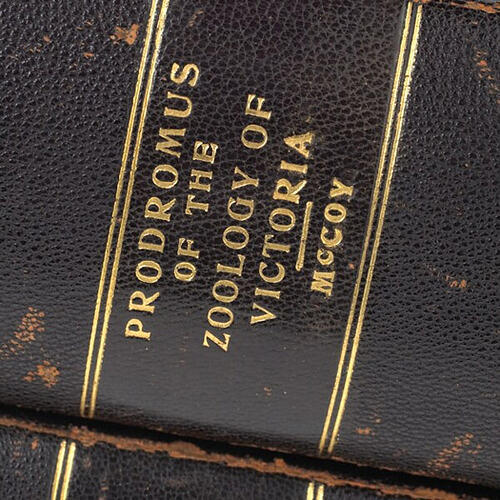
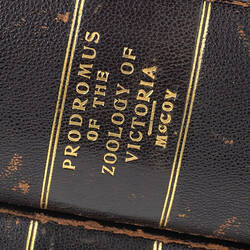
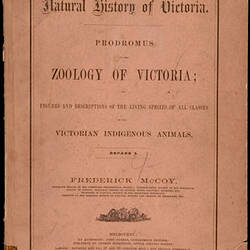
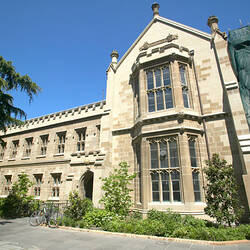
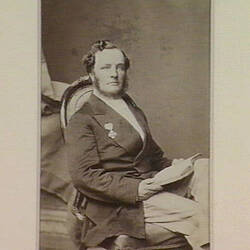
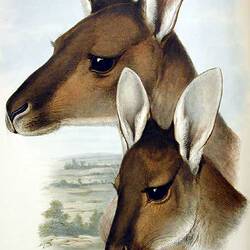
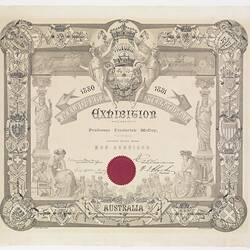
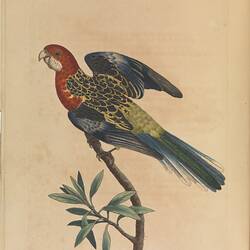
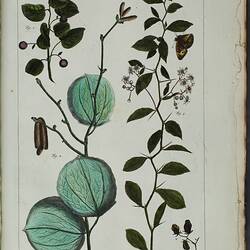
![Rare Book - Maria Sibylla Merian, 'De europische insecten, naauwkeurig onderzogt, na't leven geschildert' [bound with] 'Over de voorttelingen wonderbaerlyke Veranderingen der SurinaamscheInsecten...', Amsterdam](/content/media/43/1010343-thumbnail.jpg)
